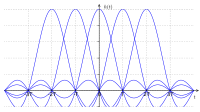
Photo from wikipedia
Abstract The measurement of blood oxygen saturation (SpO 2 ) plays an increasingly key role in medical monitoring and health detection. In order to improve SpO 2 precision, this paper… Click to show full abstract
Abstract The measurement of blood oxygen saturation (SpO 2 ) plays an increasingly key role in medical monitoring and health detection. In order to improve SpO 2 precision, this paper proposes a new method, namely bi-level pulsed frequency-division excitation (BPFDM), which uses 200 Hz and 400 Hz bi-level pulse to excite two LEDs and then utilizes the digital demodulation algorithm to synchronously obtain dual-wavelength photoplethysmogram (PPG) signals. The principle of BPFDM is theoretically analysed, and the effectiveness is illustrated by the contrast experiments among time-division method (TDM), frequency-division (FDM) and BPFDM. The experimental results show that BPFDM gets the highest SNR and the least root mean square error (RMSE) of SpO 2 % value. Compared with TDM and FDM, the SNR of BPFDM increases by 11 dB and 5 dB, and the RMSE of BPFDM reduces by 58% and 25%, respectively. So, BPFDM can significantly improve the SNR of PPG signal and SpO 2 precision under the same hardware and software conditions, which is valuable for the application in pulse oximeter.
Journal Title: Measurement
Year Published: 2018
Link to full text (if available)
Share on Social Media: Sign Up to like & get
recommendations!